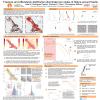Poster #147, Fault and Rupture Mechanics (FARM)
Excitation of San Andreas tremors by thermal instabilities below the seismogenic zone
Poster Image:

Poster Presentation
2020 SCEC Annual Meeting, Poster #147, SCEC Contribution #10285 VIEW PDF
The relative motion of tectonic plates is accommodated at boundary faults through slow and fast ruptures that encompass a wide range of source properties. Near the Parkfield segment of the San Andreas fault, deep low-frequency earthquakes and slow-slip events take place deeper than most seismicity, at temperature conditions typically associated with stable sliding. However, laboratory experiments indicate that the strength of granitic gouge decreases with increasing temperature above 350ºC, providing a possible mechanism for weakening if temperature is to vary dynamically. Here, we argue that recurring low-frequency earthquakes and slow-slip transients at these depths may arise due to shear heating and the temperature dependence of frictional resistance. Recurring thermal instabilities can explain the recurrence pattern of the mid-crustal low-frequency earthquakes and their correlative slip distribution. Shear heating associated with slow slip is sufficient to generate pseudotachylyte veins in host rocks even when fault slip is dominantly aseismic.























































